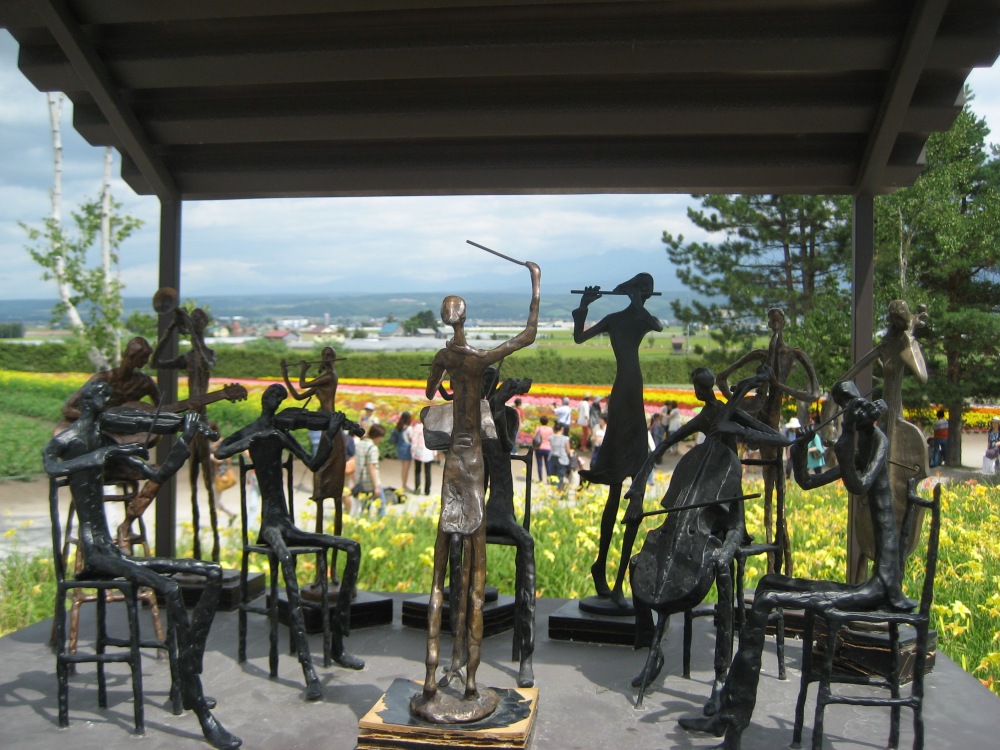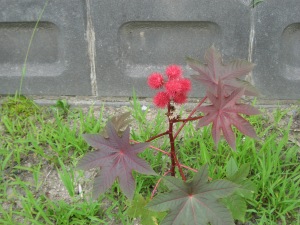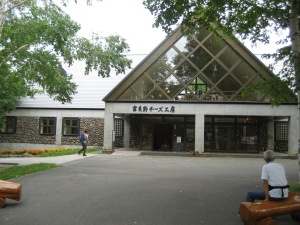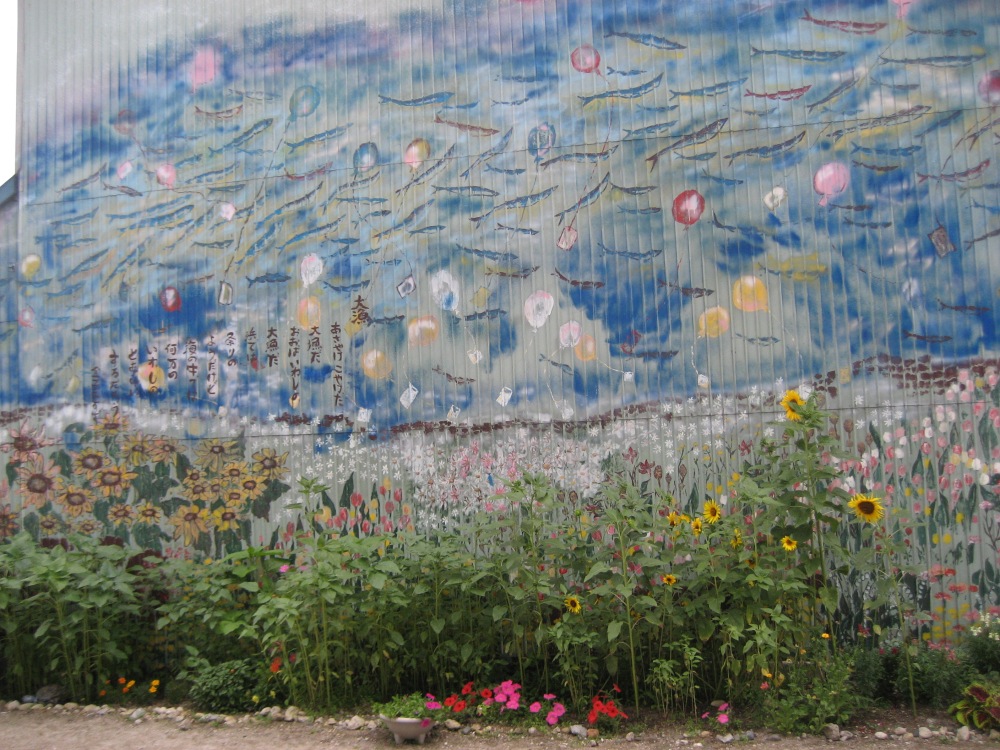Furano 富良野
Far from the hills and cliffs of Rebun Island is another flower-filled destination. Furano isn’t known for alpine wildflowers, however, so much as for its carefully cultivated fields of purple lavender and other richly colored blossoms rainbowing across the landscape. Furano is a bit of a tourist trap, but if you like flowers (or skiing in the winter), then it can be fun.
Furano is located in the middle of Hokkaido, south of Daisetsuzan National Park. Infrequent public transportation, even at peak tourist seasons, means getting around requires planning, luck, or a rental car. There’s a tourist information office at Furano Station for maps and recommendations for things to do, if the flower fields don’t captivate your attention for your whole stay. At least one staff member spoke decent English, probably because ski season is dominated by Australian tourists (as opposed to flower season, which attracts Chinese tourists). The town itself is divided by a river into two sections. Most of the accommodations are in the smaller section that doesn’t include Furano Station (which doesn’t help the transportation issue), but is closer to the ski slopes for the winter crowd. The most famous flower fields are actually north of Furano, in Nakafurano.
Furano is accessible by train from Sapporo or New Chitose Airport. From the latter, it takes about 3 hours with one transfer. If you arrive in the evening, as I did, you’ll have to get a taxi from Furano station. Beware that some of the tourist websites say that Chuo Buses go from the airport to Furano, but they don’t. It was my original plan to take one, but the ladies at the Chuo Bus counter were terribly confused by my request and informed me that there are no buses, Chuo or otherwise, that go to Furano from New Chitose. They likely do go from Sapporo to Furano, though, simply because you can get just about anywhere in Hokkaido from Sapporo.
As mentioned above, public transportation in the Furano area is limited. There’s an open-air train called the Norokko that operates only during the summer season. It’s a bit expensive, ¥540, but if the weather’s nice, it’s a lovely trip with panoramic views of the countryside between Furano Station and Lavender Station. Lavender Station is actually just a one-sided train platform a short walk from Farm Tomita and is also only open in the summer season. You can’t buy a ticket there, but it was easy to tell the ticketing agent at Furano Station where I had boarded and pay upon arrival. Japan is very trusting that way. The biggest problem with the Norokko train, as with the buses, is that they don’t operate often. As in, they make roundtrip journeys twice a day, so if you miss it, you better have a back-up plan!
Also operating in the summer season is the Lavender Bus. It has several stops in that smaller section of town, goes through Furano Station, to Nakafurano and eventually to Asahikawa. It’s a bit of a walk from the Nakafurano bus stop to Farm Tomita, but it takes you past a couple of other nice flower fields on the way, too. There are 8 roundtrip buses a day, with at least an hour between them. There is also the seasonal Kururu Loople bus, but you are required to buy a two-day pass at ¥1000 or more, and it doesn’t take you to the flower fields.
Norokko, Lavender Bus, and Kururu Bus timetables
I took the Lavender Bus to the flower fields, meeting a camera-crazy tourist from Hong Kong on board. This worked out, as I could read all the hiragana and katakana, and he could read all the kanji, so for once we could understand most of the written Japanese around us. So if you get turned around somewhere, the Chinese tourists may be able to help; I find they’re more likely to speak English than the locals, too. The best part was when he stopped to ask a Chinese girl a question, and then came back and rattled on for a good half a minute before I pointed out that I can’t understand Cantonese. The brain is fascinating.
I’ve mentioned Farm Tomita several times thus far due to the fact that it is the most popular of the flower attractions. It’s most famous for its fields of deep purple lavender, but my pictures are of its other flowers because my visit was a week into August, past lavender season. Farm workers were actually harvesting the lavender while I was there. So if the lavender fields are your goal, you must visit in July. Luckily, I find the scent of lavender to be unappealing, anyway, and was just as happy with the remaining Autumn and Hanabito fields.
Farm Tomita includes several buildings on the edges of the flower fields. Within them are typical tourist areas: shops selling souvenirs of everything lavender-scented, as well as a few other home-grown scents, an eating area and food stalls, a greenhouse, and small museums and workshops. The main building, in the above picture, has a balcony on the second floor overlooking the field. The smaller building to the left is the Dried Flower House, which has a scene created with dried flowers, as the name implies, and is worth a look.
One of the must-tries in Furano is the lavender ice cream. I bought this lavender milk popsicle at the Poppy House, where they also sell it as soft-serve ice cream. Not being a fan of the smell, I was expecting to have the same opinion of the flavor, but was pleasantly surprised.
While Farm Tomita is the most popular destination for flower viewing, there are other places. A town to the north, Biei, also has scenic attractions involving colorfully striped hills, a cerulean blue pond, and more. Tourist websites recommend staying in Biei if you’re going to explore it, since public transportation becomes even more infrequent in the evening, so making it back to your accommodation in Furano could be iffy. I don’t like flowers enough to dedicate two days to gazing at them, so I didn’t go to Biei.
There are also other things to do in Furano. The tourist map lists all sorts of little places to explore, including: Furano Winery, the Grape Juice Factory, the Cheese Factory, Furano Ropeway, and Ningul Terrace.
I chose a bike ride to the Cheese Factory to fill my post-flora afternoon. The bike rental place is just around the bus circle from Furano Station. There’s a small souvenir shop and the lady who runs it also rents out bicycles. The larger section of Furano City is flat with minimal pedestrians, so going through the town itself was a nice ride, especially considering I had not successfully ridden a bike since I was 11 years old. It gets a bit more hilly around Sorachi River, and I ended up walking the bike up the last leg of the journey, exhausted and overheated (because I was out of shape, as lamented in previous posts).
I was not overly impressed with the Cheese Factory. I think if I had come earlier in the day (it was maybe around 3pm when I arrived) I may have seen more actual production. They also have cheese and ice cream-making classes, but you have to book them in advance. They have a small pizza restaurant that uses the cheese they make on the grounds (the pizza was good if you like pizza in Japan), and an ice cream shop with some interesting flavors. The kabocha ice cream was pretty good. I say kabocha because when I say ‘pumpkin ice cream,’ I think pumpkin pie, and Japanese pumpkin foods don’t have spices. It’s a completely different experience for your taste buds.
On the top floor is a large, architecturally appealing space where you can buy dairy products and hang out near the huge windows overlooking the grounds. Among those dairy products is the unique Squid Ink Camembert Cheese. As pictured on the left, you can sample it. Squid ink is an ingredient often used in Japan. The original all-black Burger King burger bun was colored with squid ink, since it was developed in Japan. Unlike the Western-adapted use of food coloring, squid ink doesn’t make everything green on the other end. Regardless, I didn’t try it, so you’ll have to see if you gag on your own.
I haven’t mentioned accommodations yet for Furano in part because there are tons of choices and in part because my experience wasn’t great. I stayed at Pension Snowflake. Pensions are privately owned B&Bs, essentially. While the common area was impressively ski lodge-looking, the mattress on my bed was horribly uncomfortable. I had to take the covers from the other twin bed in the room and layer them on my bed to not feel like I was sleeping on a wood board. The kitchen available for use by guests was also tiny, sparsely equipped, and two staircases away from where you could eat your food (not good when you’re carrying boiling-hot instant ramen). So I wouldn’t recommend the place. Wikitravel now has a lot of other places listed as choices, including a hostel, so I suggest looking around.
Furano was the first place I visited on my summer trip to Hokkaido. I wanted to get there as early as possible, since I knew their flower season was at its end in August. While I enjoyed the fresh, pine-scented air, the colors, and the sprawling landscape, I know I probably would have given it up for an extra day on Rishiri. Still, it’s a more oft-beaten path for those who either love flowers or want to go places easier to reach than the remote destinations of Hokkaido. If you’re traveling in July, it would be worth the stop. Happy travels, globehoppers!








